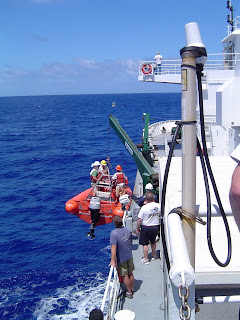Aboard the R/V KILO MOANA
Date: 8 & 9 June 2008
Geographical Area: Central Pacific, North of O’ahu
Science Log

The second photo shows Sean (only his legs are visible) climbing on the buoy while the boat circles. I don't think these stills convey how the seas are moving, which I'd estimate as 7 foot high faces and wavelengths of about 300 feet. Even tough guy Sean quietly requested some food to help settle his stomach afterwards.

The last CTD cast wrapped up yesterday. Here's a picture of some helpers like me "tagging" the lines - that is, steadying the rosette on its way back on board.

We continue to collect more science data. We're constantly monitoring data from the new buoy; a job powered mainly by computers and overseen by capable experts. Additionally, all along we've been doing some low-tech data collection. I'm actually surprised that this data is even taken, and I'm not sure of the extent to which these numbers influence science findings. Here is the psychrometer, a gadget with a fan (on the right, encased in metal) to rush air over two thermometers, one bare "dry" one, and a "wet" one with a thin wet sock covering its bulb (hidden by a metal sleeve). We record the two temperatures, and then use an equation or table to compute the relative humidity.

Here is the thermometer we use to measure sea surface temperature. It is a small PVC bucket with a fixed thermometer suspended in it. The whole contraption is lowered into the upper ocean using a rope, brought back up without spilling (luckily, the geometry makes this easy), and the sea surface temperature is read off of the thermometer before the water is dumped out. This is pretty unsophisticated stuff, but it is the most reliable method we have for measuring the sea surface temperature. (CTD's are too deep and satellites can be fooled by a slightly different temperature in a skin atop the surface.)

Personal Log
No comments:
Post a Comment